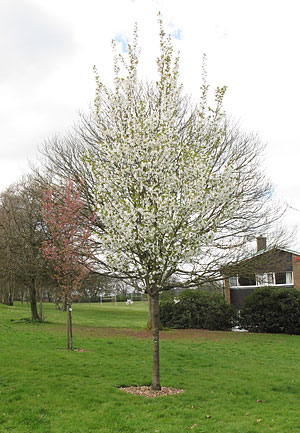Growing flowering cherries
A flowering cherry is a beautiful tree and there is a variety that will suit almost any situation. There are a few things to bear in mind though before purchasing.
 Ideally flowering cherries require full sun and good air circulation so it is important to locate your tree in an area that is not overly shaded or crowded. You therefore need to plan ahead by researching the mature height and, as importantly, the spread of your chosen cherry. As a general rule 20ft (6m) is the minimum distance between trees and 25-30ft (8-10m) for more vigorous varieties. Make sure to plant far enough away from a boundary too!
Ideally flowering cherries require full sun and good air circulation so it is important to locate your tree in an area that is not overly shaded or crowded. You therefore need to plan ahead by researching the mature height and, as importantly, the spread of your chosen cherry. As a general rule 20ft (6m) is the minimum distance between trees and 25-30ft (8-10m) for more vigorous varieties. Make sure to plant far enough away from a boundary too!
Generally cherries grow best if left alone so it is best to avoid pruning if possible but they will benefit from secure staking in the early years and protecting from rabbits where needed.
They also require a good, moist, but well-drained soil. So, if your soil is less than perfect, you may need to dig in some sand, compost or leaf mould.
The best time to plant is from the beginning of November through to the end of March; avoiding frosty or water-logged conditions. This gives the roots time to establish themselves before the top starts growing.
For planting:
- Dig a hole 2-3 times wider than the container (tree roots grow sideways more than they grow downwards, so a wide, well-prepared hole pays dividends in helping the tree establish).
- Make sure the tree is thoroughly watered before planting
- Place the tree carefully in the hole making sure to retain the same soil level in the ground as in the pot
- Backfill the hole with soil, making sure to firm it down to remove air pockets
- Fix to the stake
- Water thoroughly
- Keep the area around the tree free of other vegetation and well mulched with compost or bark chips. This area should ideally be at least half a metre wide each side of the tree.
Maintenance
- After a few years strong shoots may break out on the stem and around the graft point. It is important to remove these with a sharp knife or secateurs.
- Cherries should be pruned as little as possible and any cutting should be done in mid-summer since this is when they are most resistant to diseases.
- Cherries need plenty of water as they are very shallow-rooted but they should not be allowed to get water-logged. If they are planted in, say, a lawn then the grass can get compacted and restrict water getting to the feeding roots that are generally in line with the edge of the crown of the tree – the drip line. In these cases it is important to aerate the lawn.
Diseases of Cherries
There are number of diseases of cherries and two of the most important are listed below. However, for advice on these and other diseases it is better to consult the horticultural literature. Geoffrey Chadbund’s book “Flowering Cherries” has an extensive section on cherry cultivation and it possible to pick up second-hand copies.
Cherry leaf scorch Apiognomonia erythrostoma
Recognised by the withered leaves on the tree in the spring and summer and which remain on the tree over winter. The fungus responsible produces fruiting bodies on the leaves and the spores are shed in the spring and infect the new leaves. Yellow patches that later turn brown appear on the new leaves and the fungus migrates to the leaf stalk or petiole affecting the leaf’s ability to function properly. More information.
Cherry leaf spot Blumeriella jaapii
Purplish spots on the leaf that may fall out leaving a hole as if hit by a shot gun. The leaves turn yellowy before dropping early. Collection and burning of fallen leaves advised. More information
Bacterial canker Pseudomonas syringae
Darkened, depressed areas on trunk or branches that may exude a sticky gum. Leaves turn yellow, often with a shot hole effect, a drop early. Removal of infected areas needed.
Blossom Rot Monilinia laxa
A fungal disease that enters into the dying flowers and causes leaf and twig die-back of varying degrees of severity. It is worse in damp springs. Collection and burning of fallen leaves and shoots advised. Read more about Blossom Rot here.

